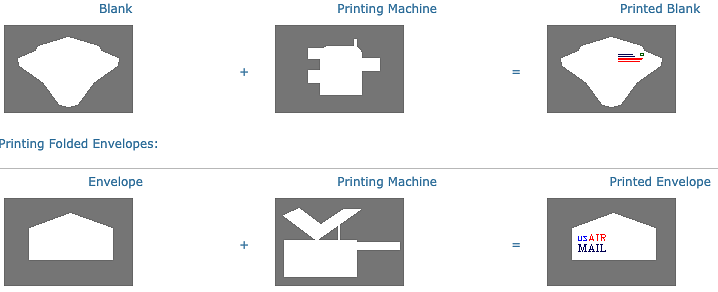Start Your Own Envelope Production
How to Start Your Own Envelope Production
There are two categories of envelope design produced today:
- Open side envelopes which include commercial, self seal, pointed, and booklet (or wallet) envelopes;
- Open end (or pocket) envelopes.
Envelopes are generally produced in three "run" sizes. For purposes of our illustration, we have defined them as:
- short runs (25,000 to 200,000 envelopes per order),
- medium runs ( 200,000 to 10,000,000 envelopes per order),
- long runs (greater than 10,000,000 envelopes).
The long run are always produced on machines that are starting from a roll of paper when the medium runs can be produced on machines that have a dual feed and the short runs are always produced on machines that are starting from pre-cut blanks. Before you can choose equipment appropriate to your needs, you must define what category of envelope design and in what quantities you wish to produce.
Basically, an envelope is produced with the following five processes for envelopes produced by a paper blank fed machine:
- Die Cutting, which cuts paper into blanks,
- Printing, which allows you to print on the inside and/or the outside of the envelope,
- WindowPunching and Patching, which cuts and patches the window film,
- Gumming and Sealing, which applies the glue on the edges of the blanks,
- Folding, to fold the blanks into envelopes.
One machine can perform several or all of these operations on-line (in one continuous process), or a different machine can be used for each step (this is called off-line production).
A simple and economical way in which to begin an envelope production business would be to invest in a machine designed for short runs of open side envelopes which will cut, fold, punch and patch a window, and gum the closing flap. A machine which meets these requirements can be purchased for approximately $20,000. To add printing capabilities would require an additional investment of approximately $30,000 to $50,000. The machine just described operates using sheets of paper. To produce long runs of envelopes, a machine which operates using rolls of paper (called webs) is required.
Assuming that all five processes are used, once the die has cut the blanks, they are first printed, then the window is punched and patched, then they are folded, and finally they are gummed.
Die Cutting
This machine cuts blanks at the dimension of the finished product by using dies (which are metallic knives, shaped to the size of the envelope prior to folding).

Criteria for selection: price, speed and dimension of the table.
Several example of Die cutting Presses:
- FL Smithe HP (Hydraulic Press)
- FL Smithe PHP (Programable Hydraulic Press)
Once these blanks have been cut, they must be folded and the closing flap must be gummed. Additional options include printing and/or including a window in the envelope (accomplished by punching the window, then patching it).
Printing, off line
A printing press can generally print blanks in one color on one side and two colors on the other side. This is generally called flexographic printing and described as 1/2 to mention 1 flexo printing inside and 2 flexo printings outside. The printing press can also print already finished envelopes. In that case, it can print only on the outside of the envelopes, and generally only offset quality.

Criteria for Selection: The type of impression, the number of envelopes in a run, and the size of the blanks/envelopes to be printed.
Corresponding Machine:
- FL Smithe HP (Hydraulic Press)
- FL Smithe PHP (Programable Hydraulic Press)
Window punching and patching, off line
When the blanks are printed, the window machine punches and patches the windows on the blanks.

Folding
The blanks (printed and punched) then go in a machine that folds and glues the envelopes. This machine is the most essential in the production of envelopes. It can be designed to produce either open side or open end envelopes.

Gumming and sealing
Most envelopes produced use dextrine gumming (also known as remoistable). However, if you need to apply special shape of gumming on the seal flap or body of the envelope there are machines which feed finished envelopes by opening the flap and apply gumming (either dextrine [remoistable], latex [self seal], or silicon tape). Other machines can apply clasps or string and two buttons.

